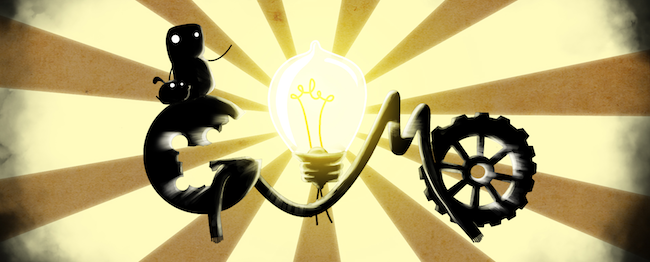
Some games will instantly resonate with their audience, and other games will sometimes take a while to grow on them. It is highly subjective, though. Gomo is a game that I must admit was a little disappointing to me, at first. I think in my mind, I was already comparing it to Machinarium, a point and click adventure game that I very much enjoyed, and have played through several times with my six year old daughter. However, with that said, I needed to play through Gomo a second time, having cast that comparison aside, to really get what the game was about.
Let’s get this out of the way first: Gomo is quite a short game, and it employs a very simple narrative premise. Essentially, there’s a simplistic background story to the adventure: an alien has come and captured Gomo’s pet dog, and will only return it if Gomo can locate a special crystal for the alien. So, with that established, off we go!

As players progress through the game, they will discover a somewhat bizarre and, at times, surreal world. It doesn’t really paint any cohesive picture of the world you are exploring since many of the items and scenes you encounter are absurd and nonsensical; which is part of Gomo’s charm. It doesn’t mean to make any sense, the fun is in the journey. There is a lot of humour spread throughout the game to be discovered. You’ll find this humour in the foreground, in the things that happen to Gomo as you play, and within the background scenes.
At it’s core, Gomo is a point and click adventure game, but in saying that, it is better compared to a game such as Machinarium in its mechanics, rather than a game such as Day of the Tentacle. It’s left-click all the way and quite simple to use. One aspect that I found somewhat frustrating, however, is that you can’t just select an inventory item and then click on the other side of the screen to get Gomo to use it there. You have to move him there first, then use the item. Movement, and the correct placement of Gomo in the scene, is part of the puzzle. Gomo is not the only game with this mechanic, but it’s not a mechanic I enjoy. At least you can right-click on the screen to quickly return the selected inventory item back to your inventory, so that you can move Gomo into position.

You’ll find that Gomo isn’t chock full of puzzles. Some screens are just there for comic effect, and Gomo will sometimes make his way amusingly through them without your help. At times, you’re just clicking Gomo through the levels, painstakingly clicking here and there just to get Gomo to move to the exit of the screen; all the while making you wish one click sufficed. At any rate, I would recommend leaving the game in “easy mode” because this highlights when a selected inventory item can be used on a certain part of the screen when you hover over it.
Gomo is also very linear in its overall design, but I think this suits the tone of the game well. From my own personal experience, some adventure games can become frustrating when you get stuck, and subsequently find yourself revisiting areas to see if you missed anything. For a short casual adventure such as Gomo, it actually works well to know that you can only go forwards, and you always possess all the tools you need to pass the current screen. If anything, it’s about discovery and Gomo’s journey, as simple as it is, rather than outright challenging puzzles.

The art of Gomo has a nice hand-drawn style to it, and the screens are often detailed and nicely drawn. There is a lot of humour sprinkled throughout the screen designs, and it adds to the game’s charms. Overall there is a very cohesive art style to the game that shows on each screen. The screen backgrounds are rather amusing and add to the charm of the game because you find yourself wondering what weird thing you’ll discover on the next screen.
There are also some interesting background animations, too, with a few nods to popular culture sprinkled in that draw your attention away from the game for a bit of a break. However, I noticed that sometimes these don’t seem to gel with the hand-drawn art style of the world you are exploring. Additionally, the music is also well-composed and suitable to the themes of the game. It is quite catchy, but I found it became somewhat repetitive rather quickly. Sadly, you can’t turn the music off or adjust its volume independently from the sound effects, so it’s all or nothing. That’s a shame because the sounds in-game are superb and characterful, like a lot of elements in this game.
 Simple design is inviting for all audiences
Simple design is inviting for all audiences Lots of characterful humour throughout
Lots of characterful humour throughout Unique art-style suits the tone of the game
Unique art-style suits the tone of the game
 Short with limited replayability
Short with limited replayability Light on conventional puzzle solving
Light on conventional puzzle solving Music can become repetitive over time
Music can become repetitive over time
Gomo is a fairly short puzzle adventure game that is somewhat light on conventional puzzle solving. However, in saying that, I still found the journey interesting none-the-less, and enjoyed my time with the game. This is mainly due to the random things you discover along the way, and the irrelevant, but funny, background animations. There’s a fair bit of slapstick “physical comedy” throughout the game in the way Gomo gets about his business, and this kind of humour works especially well with young audiences. Although the game is short and fairly linear, it is definitely worth checking out if you have a few moments to spare, and need a light-hearted distraction.











